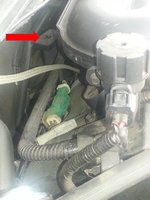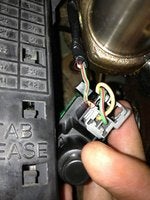2000 Ford Taurus rough idle after warmed up, turned off then back on
Asked by Gatun Mar 25, 2015 at 12:16 PM about the 2000 Ford Taurus SE
Question type: Maintenance & Repair
If the car is cold and started it runs fine no matter how long it is used without turning it off. Once the warmed-up car is turned of and the restarted the idle is between 300-500 RPMs in all ranges. I can drive the car with a little throttle and braking coordination. The car must cool before it will start and run normally again. Sometimes the idle will return to normal with a sudden surge with RPMs up to 1200-1500 and then it slowly declines to 800-900 RPMs and runs fine until turned off and restarted again.
15 Answers
It's could be a dirty Idle Air Control valve or a bad Engine Coolant Temp Sensor. Here is a very easy how to video. https://www.youtube.com/watch?v=OAj-ETd6oW8 And the video for the coolant sensor. https://www.youtube.com/watch?v=_Z9GQzMEp28
Thank you for the quick reply. I just went out and installed the Idle Air Control valve because it was both a quick replacement as well as the hoped-for solution. It seems to have resolved the low idle after restart from turning off a warmed-up engine. But, I now have an issue where once I get up to about 20-30 mph the idle stays at that rpm level and given time it will increase gradually. When I slow down the idle remains elevated. It will drop down to about 600 rpm after 30-45 seconds or so, sometimes a little longer. I’m hoping this is a break-in period for the electronics to become adjusted to having a properly operating part now in the system and "relearning/calibrating" its proper/optimal settings. Any response to that would be greatly appreciated.
I have heard that the computer has to readjust itself. You may have to change the engine coolant temp sensor also. If that is malfunctioning, it will cause either a too rich fuel mixture or too lean. That will cause the car to not idle correctly also. For example if it's telling the computer that the engine is cold when in fact it's hot, the computer will be allowing too much fuel to be burned causing poor idle and plug fouling. See if the car runs better after a couple of uses.
Well. So far we're only halfway there. I replaced the Idle Air Control valve and the low rpm issue after restart with a hot engine disappeared. In return I received, as mentioned above, a high rpm on initial start that will settle down after a minute or will remain high when traveling at roadway local speeds. I did replace the Engine Coolant Temp Sensor but that did not change anything. I've driven it for some time now with no change other than what is now in the last two days a drop from the elevated rpms to so low the engine shuts off. I have to restart it which then high idles and drops off again. I have to play with the accelerator to help it not drop so low when it comes off the high idle. I'm open to new ideas.
Have you checked this yet? Here's quite a little surprise........................ https://www.youtube.com/watch?v=Lf0SG2Fn9jw
I replaced the PCV valve as well as the tubing leading from the PCV up to the throat behind the butterfly valve at the intake manifold. The 90 degree elbow was being sucked flat. The new one has reinforcing ribs on it and is not collapsing. HOWEVER. There was no change to, and I still have, the high idle problem. I am able to hear a hissing (Actually vacuum) sound that I cannot yet isolate but it is coming from the area of the rear underside of the intake manifold. When the idle drops that hissing goes away. I need to get a listening tube and wander around behind the intake to locate which sensor or switch is acting up. BTW. There is a valve cover gasket leak that I detected when I replaced the spark plugs during some maintenance the other day. I replaced the other coolant temperature sensor just in case there was an interactivity not known through the basic data I am able to locate. I replaced that coolant sensor, the water hose where all of the sections join together under the two coolant sensors, removed the intake manifold and replaced the upper gaskets while replacing the sparkplugs. I found oil in the front left spark plug hole, which I believe to be the #4 cylinder. The PCV valve did come out with oil on the engine side, which is why I mention all of the above. Any ideas or hints are appreciated. Jim
Once you locate the vacuum leak and repair it, disconnect the negative battery terminal for about an hour. See if that resets the parameters. Not sure if you did that the first time around. Here is a video that shows many of the vac hoses to check. You may have already checked these since you just removed the intake also. Check the black intake hose on the mouth of the throttle body. I have had them crack on the underside before. Just squeeze it with the engine running. That will usually open the crack so you will notice a difference if that's the trouble............................................................ https://www.youtube.com/watch?v=s8o6UWs17bU
Yes, I had disconnected the battery for about three hours while I replaced those items. The most time consuming part was trying to get the clamps compressed and moved back to be able to remove the hoses. There is never enough room for the tools, hands and being able to squeeze and move. It did show that I had two hoses reversed top-to-bottom but, they both come into the intake throat at the same location with direct exposure to the vacuum stream. Video was informative and my efforts matched those shown. It also confirmed that I had restored all hoses and connectors to their home ports. I have not replaced all of the hoses yet as all appeared to be in good shape compared to the PCV elbow that I just replaced. But, I will replace the rest of them as following my last post I drove the car for lunch and unlike this morning when it ran well with the high idle, it was running rough with the high idle then would settle down and repeat. I thank you for finding the videos you have so far. I have done searches for the subject matter and never come up with the ones that are as close of a match as those you provide the links to. I’m sure it’s just the terminology of my searches that make the difference. I do still have the sudden drop form high idle to too low but it recovers just before it shuts off and idles at the normal speed until I accelerate again.
Another possibility could be a dirty MAF sensor. Have you tried cleaning it? There is also another sensor called the Intake Air Temp sensor. If bad, that can screw up your air/fuel mixture as well. Typically mounted on the side of the air intake box. I just got off a forum and found a couple of really off the wall scenarios. One guy said that the neutral safety switch can cause a high idle. He said if faulty, it is not letting the ECU know if the car is in N or D. Causing a high idle. Another guy said that his high idle issue was due to a faulty cruise control module. He unhooked his cruise control cable from the throttle body and it was cured. But he had no cruise. He then said that he noticed he had a dead cell in his battery so he replaced it. Then he hooked back his cruise cable and for some strange reason, everything worked normal again. Just a couple of off the wall ones to consider if all else fails.
I replaced the one vacuum line from the intake throat/air box to a distribution module on the firewall with no change. To update, I'm now experiencing what is close to a misfire but is intermittent unlike a fouled plug. It will run rough a little while and then settle down and repeat. It becomes much more prevalent during acceleration and settles down more at cruising speed. The high idle then settles down issue remains. I'll clean the MAF this evening and post the results from there. (Based on what I have been able to locate, I believe the Intake Air Temp sensor is integrated with the MAF on my 2000 Taurus SE DOHC 24V Duratec engine) I’m still confused by the hiss I hear from behind the rear of the intake manifold when the engine is acting up which then goes away when the car settles into operating correctly. The attached picture is a side shot of behind the intake. Any idea what the module in the back is named? It has two vacuum lines coming into the bottom and one electrical connector connected to the right corner just out of the picture. I believe it to be related to the transmission but the books I have and/or located do not show it.
Just for kicks, see if you can locate the cruise control shut off switch. I think it's located under the steering column. Looks like this. If you have one, shut it off and see if the RPM's drop. This will rule out the cruise control module like I read from one forum.
Will try the cruise shutoff as well. Like you I find that hard to swallow as the culprit but, according to the wiring diagram there is a shield wire connecting the Powertrain Control Module (PCM) to the hot side of the speedometer-to-Speed Control Servo and if the insulation is chafed or damaged may remotely-possibly-kinda be intermittently interfering with the signal. I will also have to regap my plugs as the book had me doing them at .042-.046. I realized today that they should be .052-.056 based on a data plate on the radiator cover which I overlooked. That should not be the issue here.
Yeah, when I was reading those far out remedies, I ran across another guy that said part of his issue was he was running the wrong thermostat. The mechanic told him he should be using one hotter than 180 degrees. Don't know how true that one is either. Well if nothing else, you will be a pro as far as working on your car goes!
I know its been two years but what did you find out? I am chasing the same issue. Thanks
I have the ohv engine. When warmed up sitting in park it eventually drops idle down to 400 or so which may cause stall. Runs fine above idle. Although stationary revving of engine hangs up idle at 1500 then slowly drops to normal 800-900. After a few minutes idle drops, runs rough, and may stall.


